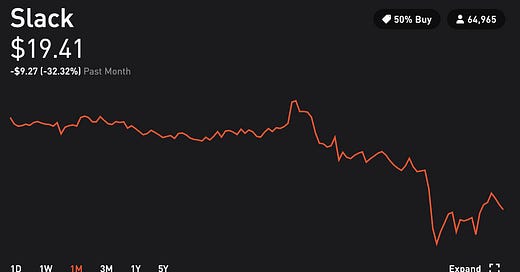Why Slack is slacking

At the moment, there are 2 accelerating trends: remote work and cross team collaboration. So, why is Slack not doing better? At first, I figured that it was mainly a sales issue; it’s hard to compete against Microsoft’s massive sales team and their experience selling into enterprises. Indeed, Stewart Butterfield recognized it as such in a recent earnings call.
We came out of the gate with near perfect product market fit for our very earliest customers who tended to be smaller and more technical teams. But over the years, as we launched the Enterprise Grid product, scaled the teams of over 100,000 users, added key features for our security, administrative control and compliance, we began to see real product market fit for the large enterprise use case. Now that fit is clear. This quarter saw win after win in the largest companies in the world.
Over the weekend, I read this blog post by Kevin Kwok that changed my perspective completely. I posted it in our product channel at work, but no one responded, so I’m sharing it again here. It’s a bit of a meandering post so I’m going to dramatize it slightly.
In his post, Kevin describes the history of work. At the advent, God created Productivity and Collaboration, and said to the world, “never shall the two of you meet”. For a while, life was good as .doc’s (and later .docx) were exchanged over emails with filenames like Board Deck v3_Final. In 2015-ish, Dropbox and Slack both said, “fuck that”, and fought it out to be one SaaS to rule them all. Five years later, it would appear that Slack has won, but it doesn’t feel that way.
Slack was supposed to be the app that became the OS, the end of the cycle on productivity. But that hasn’t happened. How should we understand what’s happening.
Slack is ubiquitous at most companies in tech (and in many other industries as well), but it doesn’t feel like it is becoming the central nervous system undergirding all the apps and workflows of its customers.
A new generation of functional apps have risen, with messaging and collaboration built directly into them as first parties. And with them it becomes increasingly clear that Slack isn’t air traffic control for every app, it’s 911 for when they fail.
Slack is 911
It’s pretty clear that Slack ≠ productivity. No one who spends an entire workday in Slack comes out of it saying, “wow, I got a lot done today”. When that happens, it usually means I fucked something up badly. These days, I find myself using Slack mainly for unplanned communication. In a perfect world, with flawless specs and self-contained Jira tickets, there would be no need for anyone to ping me on Slack, asking me what I meant when I said “make the scrolling smoother”.

Github + Jira has already allowed PMs and engineers to collaborate without back and forths on Slack. The same trend is happening with design. PMs and designers can collaborate in real-time using Freehand, then Figma. The end-result is then exported to Zeplin for engineers to consume. In this workflow, feedback can be communicated via comments within these individual apps. In some ways, we’ve come full circle from emails (async) → Slack (live) → comments (async). Because work now happens in real-time, communication can occur asynchronously. Slack is still great for asking “where the hell are the designs?!” Twitter is too.
In this context, I am also rethinking the value of our own messaging feature within Homebase. Our customers use Messages to swap shifts, communicate schedule changes, send shift notes, etc. It’s one of our most popular features, but should it be? If we built the app so that shift notes are more visible, maybe we can reduce the number of messages sent from managers to employees. In this lens, more messages might indicate a failure in our designs.
Finally, I disagree with Kevin in his conclusion. At a macro level, I don’t foresee a meta-layer across apps that functions as an office OS. That meta-layer is trust. With good planning, adequate documentation, and collaborative tools, I don’t need to know what people are doing and when they are doing it. Today, Slack came out with its new redesign, which contains some much needed quality-of-life improvements, but doesn’t address its core issues. It might take another startup and 10 more years to get another big improvement in the way we work. For now, I am just looking forward to being back in the office and sharing germs again.



